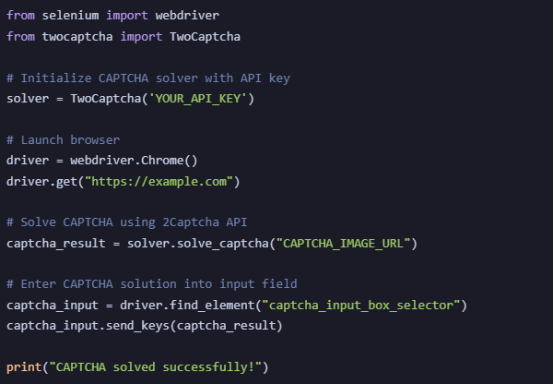How to Master Web Scraping with JavaScript in 2025
Explore web scraping with JavaScript: tools, steps, and MacroProxy solutions for dynamic data extraction.
Post Time:2025-04-18
Learn how to bypass CAPTCHA automatically using legal and ethical methods like CAPTCHA-solving APIs, AI & OCR, browser automation, rotating proxies, and session cookies.
Nowadays, CAPTCHA is widely used as websites' critical line of defense against bots. While it does protect websites and their users from automated abuse, it poses significant challenges for legitimate data collection and automation. Tired of CAPTCHAs slowing down your workflow?
In this blog, we will introduce five methods to solve it automatically and avoid blocks, including using APIs, AI & machine learning, browser automation tools, rotating residential proxies, and session cookies & trusted tokens. We will also cover what CAPTCHA is and the best practices. Let's start to improve your operations!

CAPTCHA, short for Completely Automated Public Turing test to tell Computers and Humans Apart, is a security mechanism designed to differentiate between human users and bots, and then, block bots.
Websites use CAPTCHA to:
Common Types of CAPTCHA are:
Although CAPTCHA enhances security, it also often hinders users' legitimate operations. For example:
1. Faster Web Scraping & Automation: Developers running scraping bots for SEO research, market analysis, or price tracking.
2. Avoiding CAPTCHA in Repetitive Tasks: Filling out multiple forms or logging in while dealing with CAPTCHAs can significantly slow down the workflow.
3. Improving Efficiency in Data Collection: For data extraction, bypassing CAPTCHA will speed up automation tasks.
Using CAPTCHA-solving services is legal, but scraping sites without permission can violate terms of service. For ethical CAPTCHA bypassing, please use for legitimate automation (SEO research, testing), and avoid misuse for spamming, fraud, or illegal activities.
Understanding how CAPTCHA works can help you better figure out how to solve it. In summary, it functions by presenting tasks that are easy for humans but difficult for automated programs. Below are the key steps:
1. User Interaction
When a user attempts to access a website or perform an action (e.g., logging in), the system will trigger a CAPTCHA verification and require the user to complete it before proceeding.
2. Challenge Presentation
The CAPTCHA system generates a test. Common types are as we mentioned above in "Common Types of CAPTCHA".
3. Response Evaluation
If the user’s response is correct, CAPTCHA grants access; otherwise, it presents a more challenge or directly blocks access.
4. Security Mechanisms
CAPTCHA Human Verification prevents bypass by:
Bypassing CAPTCHA automatically can be done legally and ethically for accessibility, automation testing, and improving user experience. Below are five methods in compliance with website policies.
Several services provide legal CAPTCHA-solving APIs that integrate into automation workflows. For example:
Google reCAPTCHA Enterprise – Google offers a paid version of reCAPTCHA that allows businesses to reduce CAPTCHA friction for verified users.
2Captcha API – Uses human workers to solve CAPTCHAs and return results via API.
Anti-Captcha API – Similar to 2Captcha, it provides programmatic CAPTCHA solving.
Use Cases:
AI models can recognize and extract text from image-based CAPTCHAs(OCR), and be trained on datasets to identify patterns in CAPTCHAs(Deep Learning Models). Popular tools like Tesseract OCR and TensorFlow/Keras Models.
Use Cases:
Some browser automation tools with built-in CAPTCHA handling can simulate human-like behavior, such as Selenium and Puppeteer.
Code Example:

For Copy:
from selenium import webdriver
from twocaptcha import TwoCaptcha
# Initialize CAPTCHA solver with API key
solver = TwoCaptcha('YOUR_API_KEY')
# Launch browser
driver = webdriver.Chrome()
driver.get("https://example.com")
# Solve CAPTCHA using 2Captcha API
captcha_result = solver.solve_captcha("CAPTCHA_IMAGE_URL")
# Enter CAPTCHA solution into input field
captcha_input = driver.find_element("captcha_input_box_selector")
captcha_input.send_keys(captcha_result)
print("CAPTCHA solved successfully!")
Use Cases:
A proxy acts as an intermediary between the internet and your connected device, helping you hide your real IP address and mask as the proxy server's. When a CAPTCHA system detects multiple requests from the same IP, it may trigger a challenge. By rotating IPs using residential proxies, you can potentially reduce CAPTCHA occurrences.
Use Cases:
For detailed content, you can refer to our blog "How to Bypass CAPTCHA When Using Proxies for Scraping".
Many websites store session cookies after a successful CAPTCHA verification. If these cookies are reused in subsequent requests, future CAPTCHAs can be prevented automatically.
Use Cases:
1. Can I bypass CAPTCHA without using third-party services?
Yes, but it requires advanced AI models and image recognition.
2. What is the best CAPTCHA solver for large-scale automation?
CapMonster is best for enterprise-level CAPTCHA solving.
2. How do websites detect CAPTCHA bypass attempts?
They use IP tracking, browser fingerprinting, and behavior analysis.
Bypassing CAPTCHA efficiently requires the right tools:
Want to automate without getting blocked? Try our free trial of residential proxies for secure and efficient data collection!
< Previous
Next >